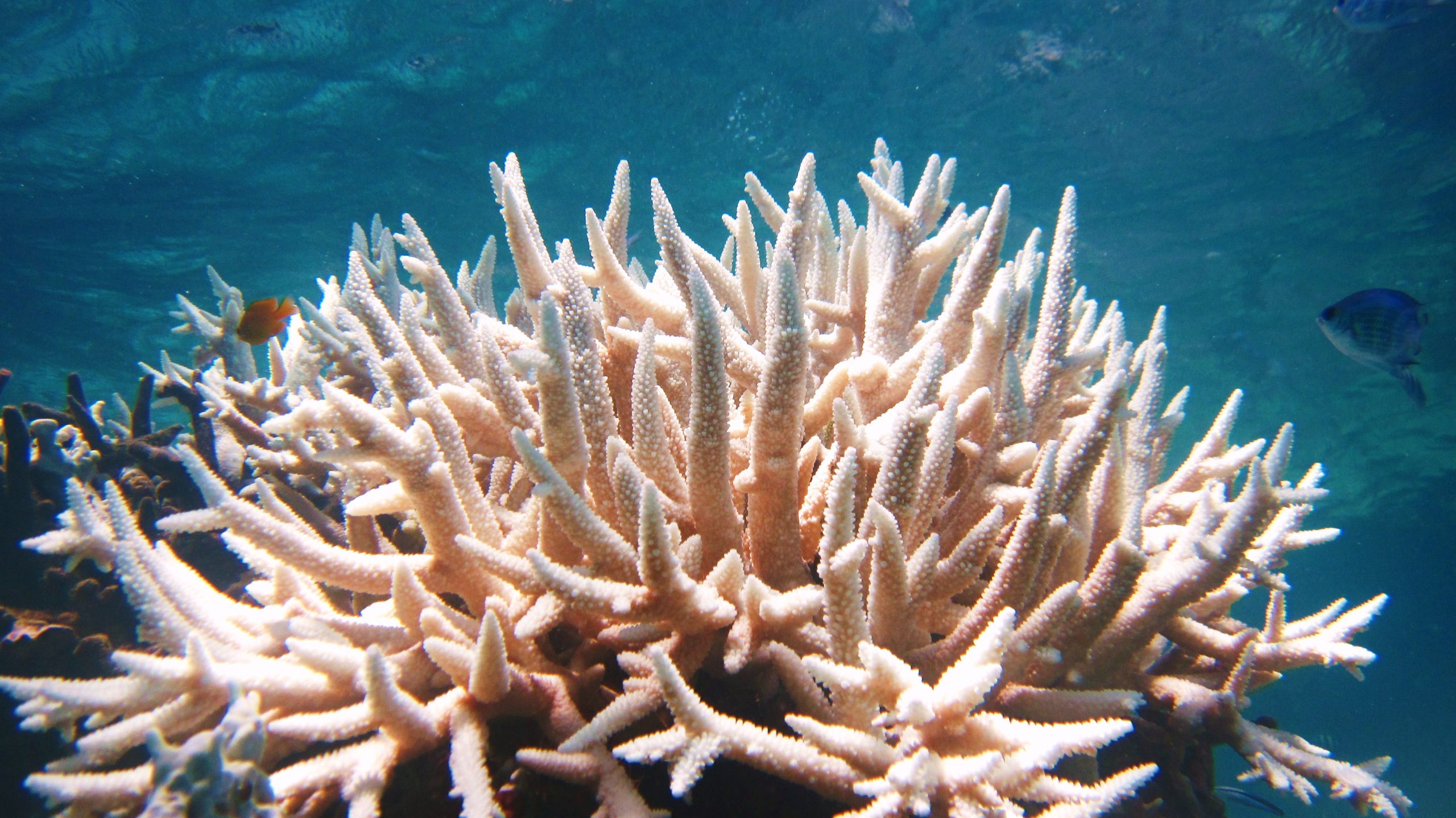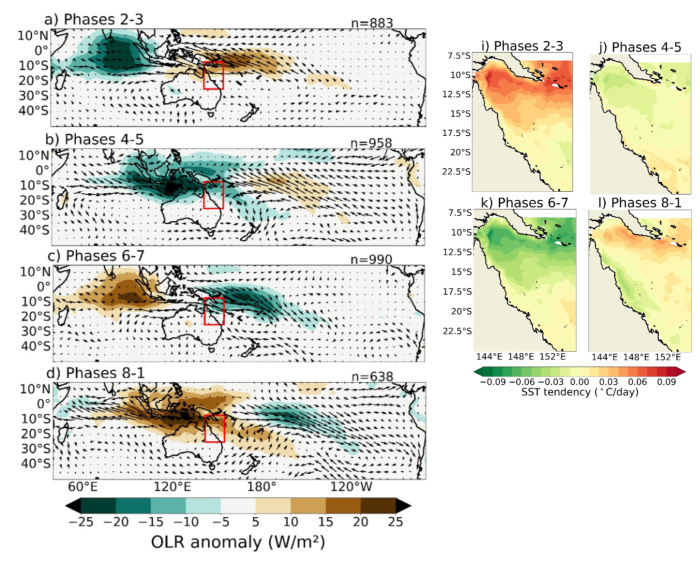Written by Laure Poncet
A new study from the Institute for Marine and Antarctic Studies and the ARC Centre of Excellence for Climate Extremes shows that the combined influence of the Madden-Julian Oscillation (MJO) and El Niño-Southern Oscillation (ENSO) can impact the weather over the Great Barrier Reef, contributing to coral bleaching events.
Corals are particularly sensitive to weather conditions over the Great Barrier Reef (GBR). Sunny and calm weather usually lead to high ocean temperatures, increasing the risk of coral bleaching, while stormy, rainy weather can cool the ocean, providing some protection to corals.
This is because calm, sunny days allow more sunlight to penetrate the water, heating the ocean’s surface, while storms and rain increase cloud cover and wind, promoting the mixing of cooler, deeper waters with warmer surface waters.
The study has found that while ENSO – a climate phenomenon involving changes in ocean temperatures in the equatorial Pacific region – influences weather over the GBR on a seasonal scale, the MJO – a slow eastward-moving storm pattern near the Equator – can alter these weather conditions on shorter, sub-seasonal timescales, leading to unexpected impacts on ocean temperatures and corals.
Clouds, rain, winds: how does weather impact corals?
Before delving into the study’s main findings, it is essential to understand first how weather impacts the GBR and its coral reefs.
The GBR, covering almost 350,000 square kilometres along the northeastern coast of Australia, is the world’s largest coral ecosystem. It is renowned for its biodiversity, cultural significance and economic value, contributing around $6.4 billion annually to the Australian economy.
However, recently, corals have been seriously threatened with significant bleaching events due to the increase in ocean temperatures resulting from climate change. When ocean temperatures rise, corals become stressed and expel their symbiotic algae, losing a primary source of food and their vibrant colours (Read more here – what is coral bleaching?).
Besides climate change, local weather patterns over the GBR influence ocean temperatures. Extended periods of sunny, weak wind days during the austral summer months can significantly raise the risk of coral bleaching. When there’s less cloud cover, more sunlight can reach the ocean’s surface, causing the water near the reefs to warm up. Additionally, weak winds reduce the mixing of water masses, allowing heat to build up in the ocean’s upper layers. Conversely, the risk of coral bleaching decreases during storms or high rainfall, as increased cloud cover lowers ocean temperatures, and strong winds increase the mixing of warmer surface waters with cooler deep waters.
Source: https://wavedancerlowisles.com/about-low-isles/what-is-the-great-barrier-reef/

How does ENSO influence the weather and coral health in the GBR region?
ENSO is a natural phenomenon associated with changes in sea surface temperatures in the central and eastern tropical Pacific. During an El Niño phase, temperatures in these regions are warmer than average, while they are cooler than average in a La Niña phase.
This variability can have a significant impact on the meteorology over the GBR, indirectly affecting ocean temperatures and coral health in the region. The influence of ENSO is particularly crucial as its peak phase aligns with the austral summer, i.e. when corals are most at risk of bleaching.
During an El Niño event, increased rainfall occurs in the western Pacific, while high-pressure systems with low wind speeds prevail in the eastern Pacific (Figure 1, left column). In the GBR region, this sunny, still summer weather acts to increase ocean temperatures, enhancing the risk of coral bleaching. Extreme El Niño events were the leading drivers of the mass bleaching events that occurred in 1983, 1998 and 2016 in the GBR. On the other hand, during La Niña, increased rainfall occurs over the eastern Pacific (Figure 1, right column). In the GBR region, tropical storms form and provide cooling relief to corals through increased cloud cover, rainfall, and stronger winds.
Therefore, understanding how El Niño and La Niña impact weather patterns can help anticipate coral bleaching events. While these patterns are generally predictable on seasonal time scales, researchers have found that the Madden-Julian Oscillation (MJO), a slow eastward-moving storm pattern near the Equator forming in the Indian Ocean, can disrupt these patterns on shorter, sub-seasonal time scales. This can lead to unexpected weather variations in the GBR, which in turn can affect ocean temperatures and corals.

The study’s findings: the MJO influences weather patterns in the GBR region
The study found that MJO influences weather patterns in the GBR as it moves eastward during the extended austral summer (November to April).
Figure 2 shows the propagation pattern of the MJO during that period (a-d) and the associated changes in sea surface temperatures (i-l). A negative outgoing longwave radiation (OLR) anomaly indicates cloudy skies while a positive OLR anomaly represents clear skies.
When the MJO forms in the Indian Ocean – indicated by a negative OLR anomaly, the GBR region experiences clear skies and low wind speeds (Figure 2a). This acts to increase ocean temperatures in the GBR (Figure 2i) raising the likelihood of coral bleaching events.
As the MJO propagates eastward and moves across the Maritime Continent – the region encompassing the islands between the Indian Ocean and Pacific Ocean – , cloud cover begins to increase in the GBR region (Figure 2b). Cloud cover and wind speed over the GBR are at their maximum when the MJO passes the Australian Continent and moves across the Pacific Ocean (Figure 2c). This brings cooling relief to corals in the GBR, decreasing the risk of bleaching (Figure 2k).

The study’s findings: the combined influence of MJO and ENSO on weather patterns in the GBR
The MJO and ENSO are connected. The MJO can promote the onset of El Niño by contributing to the build up of warm water in the central equatorial Pacific. On the other hand, ENSO can impact the longitudinal extent of the MJO.
In their study, the team of researchers explored the combined influence of the MJO and ENSO on weather patterns in the GBR. While ENSO gives the seasonal background context of weather patterns, they found that the MJO can alter these patterns on sub-seasonal timescales, leading to unexpected weather variations and impacts on corals.
Specifically, they demonstrated that during La Niña the MJO adopts a standing pattern, meaning it tends to stay relatively stationary in the Indian Ocean and doesn’t propagate beyond the Maritime Continent. This leads to less cloud cover and weaker winds over the GBR and acts to increase ocean temperatures in the region. This phenomenon can explain the bleaching event observed in the 2022 La Niña year.
In contrast, during El Niño, the MJO tends to propagate eastward more rapidly. This brings periods of stormy conditions to the GBR disrupting the background dry and sunny conditions caused by El Niño (Figure 1, left). Increased cloud cover and stronger winds provide a cooling relief to the corals. This phenomenon could help explain why there was no widespread bleaching during the 2009/10 El Niño year.
Looking ahead…
It has been shown that the MJO can significantly influence the weather variability over the GBR, altering the expected states of El Niño and La Niña periods.
While climate change is still the greatest threat to corals, this finding emphasizes the importance of considering the impacts of climate modes like ENSO and MJO, including their compounding effects, to assess the additional risks to corals.
Understanding their combined influence and their impacts on weather patterns in the GBR will enhance our forecast capabilities and help marine resource managers make informed decisions to preserve and protect the integrity of the GBR.
Additionally, it is crucial to understand how climate change might alter the behavior of the MJO and ENSO and understand what impact this could have on the GBR. The MJO is expected to experience an eastward longitudinal expansion and an overall acceleration in propagation speed, while the changes to ENSO are still unknown. This knowledge will be vital for developing adaptive strategies to safeguard the future of the GBR.
